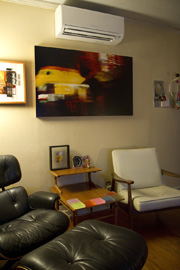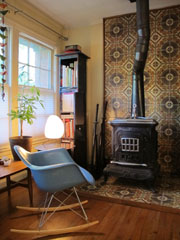By Rita Cook
Dallas resident and architect Alicia Quintans knows about living green. In fact she says “I grew up on a farm so a sustainable lifestyle is very familiar. My grandparents were farmers and home-grown produce was available all year round. My family lived in a farmhouse with no central a/c and butane heaters. The house was designed to allow for air flow and we often slept on the screened porch in the summer.”
Her husband Joel is a green thinker too riding his bike a few days each week from Oak Cliff to Arlington where he is an art director at UT Arlington. So, in keeping with their green minded lifestyle it’s no surprise the couple also decided to make some major eco-friendly changes to their home over the past few years. Undertaking both a kitchen and bath remodel, the recent changes leave good ideas for any green-minded “do it yourselfer.”
“Research went into every decision,” Quintans says. “The house had old blown-in cellulose insulation and we decided to install spray-in foam insulation on the underside of the roof, which allowed us to capture much-needed storage space in the attic. The foam was more costly than new cellulose, yet the benefit was worth the added expense. We see less dust in the house and attic plus the house remains a constant temperature.”
Also incorporated into the remodel and changes were window replacements, a tank-less hot water heater, low-wattage lighting, a dual flush toilet in the bathroom and a Mitsubishi Mr. Slim ductless mini-spit air conditioning + heating system installed this past summer to replace the window units.
 “I researched air conditioning and heating options for years before finding the right fit. Quotes for traditional ducted systems ranged from 7K to 10K, and most A/C contractors discouraged me from using the ductless mini-split systems,” Quintans says. “We also really did not want to take the attic storage space away for ducts and equipment. I finally spoke with Jack Schmidt of Benchmark Services, who was recommended by Mitsubishi. He installed the Mr. Slim system at half the cost of a ducted system. We have a very small condenser outside, and were allowed to keep the attic space.”
“I researched air conditioning and heating options for years before finding the right fit. Quotes for traditional ducted systems ranged from 7K to 10K, and most A/C contractors discouraged me from using the ductless mini-split systems,” Quintans says. “We also really did not want to take the attic storage space away for ducts and equipment. I finally spoke with Jack Schmidt of Benchmark Services, who was recommended by Mitsubishi. He installed the Mr. Slim system at half the cost of a ducted system. We have a very small condenser outside, and were allowed to keep the attic space.”
Quintans says the tank-less water heater was an upgrade with value too when they replaced a 30-year old tank water heater that had seen better days.
“We will never need to replace the tank-less and gained a storage closet,” she adds.
They also researched solar panels for the house, but discovered it was not feasible, however Quintans says “I still hope solar could be an option for us in the future if supply and demand levels out. We have a perfectly simple roof for the panels.” As for how much money the couple is saving she says “With weekly reports from Reliant, we saw immediate results. Our energy usage the week after installation was half the amount of the prior week. Our average energy bill is about $70 per month, so we are not big energy consumers. With insulation and Mr. Slim, the indoor temperature stays very constant and comfortable even during the hottest summer on record.”In winter months they supplement the heating with a wood-burning stove, a feature of the home installed by previous owners.
As for how much money the couple is saving she says “With weekly reports from Reliant, we saw immediate results. Our energy usage the week after installation was half the amount of the prior week. Our average energy bill is about $70 per month, so we are not big energy consumers. With insulation and Mr. Slim, the indoor temperature stays very constant and comfortable even during the hottest summer on record.”In winter months they supplement the heating with a wood-burning stove, a feature of the home installed by previous owners.
Are they finished you might wonder?
Not yet, Quintans says the next step is to begin another phase next month to complete replacement of the original single-pane windows.
Not sure where to start on your own home, Quintans offers these five tips to anyone thinking about working an existing home into eco-friendly
• Create a tight envelope and reduce air infiltration by caulking windows and doors;
• Use a rain water collection system to water landscaping – anyone can find how-to instructions online;
• With winter approaching, live outside the comfort zone. Keep thermostats lower and wear more layers in the home. In the summer, set thermostats higher;
• Good insulation is a value worth the cost;
• Next time the water heater needs replacement consider a tank-less version.
(Photo Credits: Joel Quintans)









